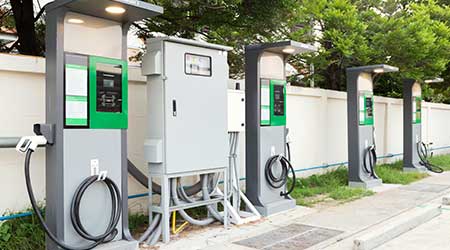
Take Charge of EV Infrastructure
September 27, 2019
Electric vehicle adoption is expected to grow exponentially in the US over the next couple of years. BloombergNEF expects EVs to make up 60 percent of the US vehicle sales market by 2040. Traditional ICE (internal combustion engine) powerhouses like the Ford F150 and Jeep Wrangler are debuting EV models, and the startup EV world is heating up with Tesla competitors like Rivian and Bollinger coming to market soon. The part of the equation that is going to have to figure itself out sooner than later is what facility managers are going to do when all those EVs park in their lots and look for a spot to juice up.
Currently, EV charging is often offered as an amenity, free to the user. Charging stations are relatively cheap, and plunking a couple of them in a prominent spot gives a facility green cred, all at a relatively minor incremental increase in electricity spend. Offering charging for free also avoids the hassle of having to figure out chargeback mechanisms.That’s fine, when there’s one or two EVs on your lot. What happens when it’s a quarter or half of the vehicles parked at your facility?
Having a large percentage of employees who drive EVs charging their vehicle at work poses several challenges to commercial facilities, as outlined by the Rocky Mountain Institute (RMI). Assuming a facility has the infrastructure in place to charge many EVs at once, one obvious challenge is who pays for all of that electricity. Additionally, RMI points out that EVs arriving at a workplace will be charging up in the morning, when a lot of other systems are also powering up. This could very likely lead to peak demand charges that would otherwise not exist.
Sure, facility managers could avoid these problems by keeping charging stations few and far between. But as EVs become the norm, drivers are going to expect they’ll be able to charge up where they spend a good chunk of their day: at work. In addition, more municipalities are building EV infrastructure minimums into their building codes. In Boulder, for example, 10 percent of parking spaces at commercial facilities have to be EV-capable.
RMI proposes three front-line strategies to help commercial facilities benefit from the EV boom while not letting it blow up their utility bills. Step 1 is submetering the EV charging stations to give facility managers the necessary data to have a conversation with their customers or employees. The second strategy is to manage charging with smart charging stations that can shift charging to a non-peak part of the day, helping to flatten the load on the facility. And lastly, charging stations should be looped into the building management system to add additional controls capability.
One strategy not discussed by RMI is that EVs are a great way to soak up excess solar and wind generation. Some manufacturers make stand-alone EV charging stations that have onboard solar panels. Other manufacturers make mobile vehicle charging stations, essentially big battery packs on wheels. These could be charged at off-peak hours and wheeled around to EVs needing power in the lot, potentially allowing a facility to provide the charging amenity without having to install row after row of charging stations.
Naomi Millán is senior editor of Building Operating Management.
Next
Read next on FacilitiesNet












